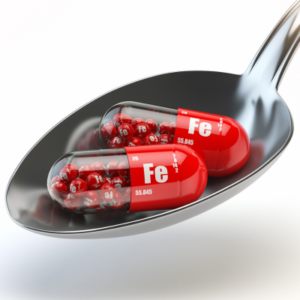 Whether you currently suffer from a low iron or are at risk for an iron deficiency, you may want to begin introducing more iron into your diet.
Whether you currently suffer from a low iron or are at risk for an iron deficiency, you may want to begin introducing more iron into your diet.
Iron is elemental in helping transport oxygen throughout your body. Without a proper amount of iron in your daily life, you may wind up feeling some of the symptoms of iron deficiency. With the help of this article, you will learn how to add more iron into your diet safely.
You may be wondering if you have low iron. Take a look at some of the following symptoms to help determine if you have an iron deficiency.
- Fatigue
- Shortness of breath
- Cold hands or feet
- Dizziness
- Rapid heartbeat
- Brittle nails and hair
- Pale or ‘Sallow’ appearance
- Pica (cravings for non-food items)
If any of these symptoms ring true for you, you might want to think about scheduling an appointment with your doctor. Many of these symptoms can mean multiple things so you should ask your doctor for a proper diagnosis. Talk to your OB-GYN about your concerns and any symptoms you may be having.
Who is at Risk for Iron Deficiency
While women are more likely to suffer from low iron than men, there are some women who are at a higher risk than others. The average woman between the ages of 14-50 should consume between 15mg and 18mg of iron on a daily basis. Use the below guide to determine if you are at a high risk for low iron levels.
Pregnant Women
Women who are pregnant need on average about twice as much iron in their bloodstream than non-pregnant women. A pregnant woman should consume 27mg of iron a day to cope with her growing fetus, and higher volume of blood levels.
Pregnant women who do not get enough iron on a daily basis are at a higher risk for a preterm birth or below-recommended weight for their little one.
Menstruating Women
Due to the loss of blood from your menstrual cycle, you may suffer from symptoms associated with low iron. Without proper iron levels throughout menstruation, you can deplete your irons stores causing month long fatigue. Introducing more iron into your diet during your period can keep iron stores built up.
Women who are menstruating should consume 18.9mg of iron and teenagers should consume 21.4mg during menstruation.
Women Before and After Surgery
Iron levels are critical to women going into surgery due to blood loss. If you plan to have surgery, your doctor may recommend adding more iron into your diet beforehand. Your doctor will likely continue to keep you on higher levels of iron than average until it is determined, your stores are built up enough.
Nutritional Tips to Safely Add Iron into Your Diet
While your doctor may recommend iron supplements, getting enough iron through your food is the safest option. Adding some of these minor dietary changes to your daily routine can have a significant impact on your life. You may begin to feel more energy almost immediately. You may also notice healthier hair, nails, and skin.
Below, you will find several tips on how to make minor dietary shifts to help improve and maintain your iron levels.
- Don’t skip breakfast. Most of your daily iron is going to come from whole grain breakfast cereals with added iron.
- Say hello to seafood. Clams, mussels, and oysters are filled with iron. Halibut, salmon, and tuna are also great sources of iron. When consuming fish that contains higher-mercury levels, stick to 12 ounces or less a week, especially if pregnant.
- Introduce snacks loaded with iron into your daily diet, such as hummus or other bean dips. Add whole-grain crackers or bread for an added boost of iron.
- Switch up your greens. When ordering a salad, choose one that has iron-rich greens such as spinach instead of iceberg or romaine.
- Avoid drinking caffeinated beverages when consuming iron-rich foods. Caffeine can have adverse effects on how your body soaks in iron.
- Add Vitamin C-rich foods such as oranges or tomatoes to the same meal as foods high in iron. Vitamin C can help your body absorb iron.
Final Thoughts
If you still have concerns about your iron levels, don’t hesitate to contact us. Your doctor may recommend making an appointment for further diagnosis of your symptoms.


